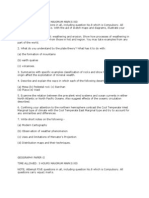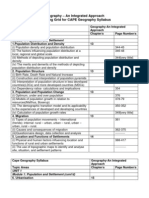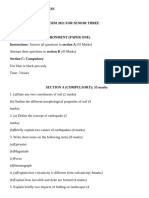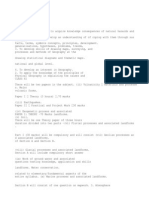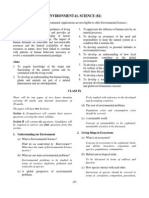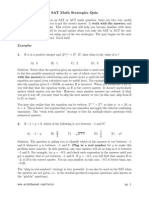Content Outline - Caribbean CSEC Geography
Content Outline - Caribbean CSEC Geography
Uploaded by
S.L.L.CCopyright:
Available Formats
Content Outline - Caribbean CSEC Geography
Content Outline - Caribbean CSEC Geography
Uploaded by
S.L.L.COriginal Description:
Copyright
Available Formats
Share this document
Did you find this document useful?
Is this content inappropriate?
Copyright:
Available Formats
Content Outline - Caribbean CSEC Geography
Content Outline - Caribbean CSEC Geography
Uploaded by
S.L.L.CCopyright:
Available Formats
10/23/13
Content Outline - Caribbean CSEC Geography
Caribbean CSEC Geography
Yard (yaad)
Content Outline
CSEC SBA
Preparation
Glossary
Usefull links
more...
OUTLINE
ORGANISATION OF THE SYLLABUS
The syllabus is organised under four main sections:
Section I - Map Reading and Field Study;
Section II - Natural Systems;
Section III - Human Systems;
Section IV - Human -Environment Systems.
CONTENT OUTLINE
SECTION 1 - MAP READING AND FIELD STUDY
CONTENT
locate places, using four and six-figure grid references;
use scale to measure distance;
give direction using compass bearing and the 16 points compass;
read and interpret conventional symbols on a map;
reduce and enlarge a section of the map;
draw and interpret cross sections and sketch sections;
calculate gradients using ratios;
describe the drainage, vegetation, land use, settlement, communications of a map;
caribbeanhighschoolgeography.weebly.com/content-outline.html
1/4
10/23/13
Content Outline - Caribbean CSEC Geography
describe landforms through the reading of contours;
explain the relationship among the patterns of relief; drainage; vegetation;land use; settlement; communication.
Interpret geographical data.
locate places using latitude and longitude;
find the latitude and longitude of a given place;
calculate the time of places;
draw sketch maps to show relative location and spatial distribution;
draw diagrams to illustrate geographical features,
locate territories in the Caribbean;
construct bar and line graphs, divided circles and pie charts;
interpret tables, dot maps, choropleth and isopleth maps, bar graphs and line graphs and divided circles;
collect, record, and present information based on field work on at least one tropic
SECTION ll NATURAL SYSTEMS
CONTENT
1. Internal Forces
(i) Theory plate tectonics.
(ii)
(iii)
(iv)
(v)
(vi)
(vii)
Types of plate boundaries.
Global distribution of plate boundaries.
Caribbean and adjacent plate boundaries.
Formation and distribution vi earthquakes, volcanoes and fold mountains.
Intrusive volcanic features, (sills, dykes, batholiths,) and extrusive volcanic features (cones and plateaux,).
changes in intrusive and extrusive volcanic features over rime.
2. External Forces
(i) Definitions of denudation, weathering, mass wasting and erosion.
(ii) Weathering types (physical, chemical, biotic).
(iii) Processes of weathering. (carbonation, oxidation, solution, frost-action, pressure release, temperature changes,
biotic).
(iv) Mass wasting (lands/ides and soil creep).
(v) Conditions influencing landslides and soil creep.
3. Rivers
(i)
The water cycle.
How water flows on reaching the surface.
(ii) Pathways water takes on reaching the surface.
(iii) River processes: erosion, transportation, deposition. River valleys Land-forms - rapids, waterfalls, gorges, ox-bow
lakes, flood plain, levees, meander and braiding (bars), river cliffs, point bar, deltas.
(iv) Drainage patterns.
4. Limestone Environment
(i) Characteristics of limestone (chemical composition, structure, permeability).
(ii) Processes occurring in limestone areas and landforms created both on the surface and underground, swallow
holes, caves, stalactites, stalagmites, pillar).
(iii) Karst landforms in the Caribbean (conical hills and cockpits).
5. Coasts
(i) Wave types (constructive, destructive).
(ii) Wave processes and resulting landform. (cliff, notch, wave-cut platform, headland and hay, caves, arches,
stacks, beaches, spit,
caribbeanhighschoolgeography.weebly.com/content-outline.html
2/4
10/23/13
Content Outline - Caribbean CSEC Geography
(iii) Types of coral reefs in the Caribbean (flinging, barrier,)
(iv) Location, distribution of coral reefs in the Caribbean.
(v) Conditions necessary for the successful formation of coral reels.
6. Weather, Climate, Vegetation and Soil
(i)
(ii)
(iii)
(iv)
(v)
(vi)
(vii)
Differences between weather and climate.
Caribbean weather systems (hurricanes, tropical waves, cold fronts, anticyclones, JTCZ).
Influence of relief on climate in the Caribbean.
The components of an ecosystem-human, climate, vegetation, oil (living andnon-living components).
Location of equatorial, tropical marine and tropical continental regions.
Climates, vegetation and soil of the equatorial, tropical marine and tropical continental regions.
The relationship between the climate, vegetation and soils of equatorial, tropical marine and tropical
continental regions.
SECTION lll - HUMAN SYSTEM
7. Population and Settlement
(i)
(ii)
(iii)
(iv)
(v)
(vi)
(vii)
(viii)
Factors influencing population distribution and population density in a named Caribbean country.
Factors affecting population growth in ONE Caribbean country and in ONE developed country.
Definition of urbanization.
Reasons for urbanization in the Caribbean.
Population growth of ONE Caribbean capital city within the last 20 years;
Benefits and problems of urbanization in capital city in Objective;
Ways of controlling urbanization in the Caribbean;
Patterns and consequences of international migration in one named Caribbean country within the last
20 years.
8. Economic Activity
(i)
(ii)
(iii)
(iv)
(v)
(vi)
Characteristics and relative importance of primary, secondary and tertiary economic activities to the
Caribbean.
Location of one example of each of the following economic activities:
(1) one example of Primary fishing or forestry or mining (bauxite or gold or oil and natural gas);
(2) one example of Secondary - garment industry or food processing;
(3) one example of Tertiary - tourism.
Factors influencing the location of economic activity chosen in (ii): physical, human, economic.
Trends in each economic activity chosen in (ii).
Challenges in each economic activity chosen in (ii) - globalization, technology, marketing [for example,
Caribbean Single Market and Economy (CSME), European Union (EU)] and sustainability.
For the secondary industry chosen in (ii), compare a named Caribbean country with a newly industralised
island either Hong Kong or Singapore.
(vii) Importance of agriculture to the Caribbean region.
(viii) Changing role of agriculture, for example, trends in employment, contribution to Gross Domestic Product
(GDP) in the Caribbean, acreage, diversification, marketing arrangements.
(ix) Location of commercial arable and peasant farming in ONE Caribbean territory.
(x) Characteristics of commercial arable and peasant farming in a country selected in (ix).
(xi) Characteristics of commercial arable farming in Caribbean and Prairie Provinces of Canada.
(xii) Trends in commercial arable farming in the Caribbean and the Prairie Provinces of Canada.
SECTION IV - ENVIRONMENTAL SYSTEMS
9. Natural Hazards
a.
Definition of a natural hazard.
b.
Impact of one of the following on life and property: volcanic eruption or earthquake or hurricane.
c.
Responses to one hazard/n a Caribbean country.
(i)
Individual responses (preparedness, community involvement).
(ii)
National responses (national disaster organization activities [for example,
Office of Disaster Preparedness and Emergency Management, (ODPEM), role of national
organizations.
caribbeanhighschoolgeography.weebly.com/content-outline.html
3/4
10/23/13
Content Outline - Caribbean CSEC Geography
(iii)
Regional responses [for example, activities of Caribbean Disaster and Emergency Relief Agency
(CDERA)J.
10. Environmental Degradation
d. Pollution
(i) Definition of pollution.
(ii) Types of pollution (air, water, land).
(iii) Location of area in a named Caribbean country where pollution is a major problem.
e. Global Warming
(i)
(ii)
(iii)
(iv)
Definition of global warming.
Long-term changes in global temperatures.
Causes of global warming.
Consequences of global warming (for example, climate change and sea level rise in one named Caribbean
country and either Mauritius or Maldives).
(v) Measures to reduce the impact (for example, forest conservation, use of renewable energy resources, changes to
vehicle emissions) in a developed country.
f. Coral Reef Destruction
(i) Causes of coral reef destruction (for example, sedimentation, sewage pollution, tourism).
(ii) Consequences of coral reef destruction (for example, coastal erosion, decline in fish stock).
(iii) Measures to reduce the impact in one Caribbean territory.
g. Deforestation
(i) Causes of deforestation (for example, squatting, lumbering, agriculture, mining).
(ii) Consequences of deforestation (for example, loss of flora and fauna, soil erosion, flooding, decline in
underground water).
(iii) Measures to reduce the impact of deforestation in one named Caribbean territory.
Create a free website with
caribbeanhighschoolgeography.weebly.com/content-outline.html
4/4
You might also like
- Carib Studies Past Papers AnswersDocument47 pagesCarib Studies Past Papers AnswersStephen Pommells71% (17)
- Caribbean Studies EssaysDocument29 pagesCaribbean Studies EssaysRosemaryReynolds40% (5)
- Geography Past PapersDocument13 pagesGeography Past PapersRafay Ali50% (2)
- Carib Studies Past Papers AnswersDocument45 pagesCarib Studies Past Papers AnswersAnita Jaipaul0% (1)
- A Suitable Boy SummaryDocument1 pageA Suitable Boy SummaryS.L.L.CNo ratings yet
- Flow NetsDocument24 pagesFlow Netsrocky21st0% (1)
- Geography SyllabusDocument11 pagesGeography SyllabussierrapersadNo ratings yet
- Geography Cape Exam Notes: Done by Amelia TaylorDocument14 pagesGeography Cape Exam Notes: Done by Amelia TaylorAmelia TaylorNo ratings yet
- Geography (1)Document52 pagesGeography (1)arunkumarbisoyi99No ratings yet
- Cape Geography SyllabusDocument9 pagesCape Geography SyllabusKern Grant100% (2)
- Geography Physical and Human Exam of The Third Term 2021 For s3Document21 pagesGeography Physical and Human Exam of The Third Term 2021 For s3homev780No ratings yet
- ISC GeographyDocument11 pagesISC GeographyRAGHUBALAN DURAIRAJUNo ratings yet
- Rajasthan Public Service Commission, Ajmer: Rajasthan State and Subordinate Services Combined Competitive ExaminationDocument3 pagesRajasthan Public Service Commission, Ajmer: Rajasthan State and Subordinate Services Combined Competitive ExaminationAgarwal AakashNo ratings yet
- Preliminary Examination of Civil Services Exam: (Syllabus)Document3 pagesPreliminary Examination of Civil Services Exam: (Syllabus)Somu TiwariNo ratings yet
- History, Civics and Geography (50) Geography: AimsDocument8 pagesHistory, Civics and Geography (50) Geography: AimsChandu SagiliNo ratings yet
- Syllabus20 20IM201320Geography202024Document8 pagesSyllabus20 20IM201320Geography202024shabanguandile520No ratings yet
- Geography General ObjectivesDocument9 pagesGeography General ObjectivesHamak Twotorial KollegeNo ratings yet
- Geography F 2. Marking SchemeDocument6 pagesGeography F 2. Marking Schemeluckse24No ratings yet
- Www-Ecolebooks-ComDocument46 pagesWww-Ecolebooks-Combabatunde oladejiNo ratings yet
- WWW Ecolebooks Com...Document44 pagesWWW Ecolebooks Com...babatunde oladejiNo ratings yet
- CAPE CS Questions & AnswersDocument50 pagesCAPE CS Questions & AnswersKareem MckenzieNo ratings yet
- 1979-2015 Geography Optional Questions of Last 37 Years PDFDocument101 pages1979-2015 Geography Optional Questions of Last 37 Years PDFanil kumarNo ratings yet
- 013 Geography MsDocument11 pages013 Geography MsdaudNo ratings yet
- Geography Hon.Document18 pagesGeography Hon.Bijay Krishna DasNo ratings yet
- Geography: History, Civics and GeographyDocument7 pagesGeography: History, Civics and GeographyVishaal ShuklaNo ratings yet
- Ap Exam ReviewDocument4 pagesAp Exam ReviewKathy DanielsNo ratings yet
- Caribbean Studies SyllabusDocument5 pagesCaribbean Studies SyllabusSarah P.No ratings yet
- PastQuestionsJan2009Jan2012withanswersCROWDED COASTSDocument12 pagesPastQuestionsJan2009Jan2012withanswersCROWDED COASTSParco300No ratings yet
- Mark Guide - CRM Ol Geo 2 - 2023Document5 pagesMark Guide - CRM Ol Geo 2 - 2023mbenaziaNo ratings yet
- Geography Past PapersDocument15 pagesGeography Past PapersNaseeb AliNo ratings yet
- 2020 Nusgc Individual Component QuestionsDocument15 pages2020 Nusgc Individual Component QuestionsTerra JurnalNo ratings yet
- Carib Studies Questions and AnswersDocument43 pagesCarib Studies Questions and AnswersAHKEEL LESTER JONESNo ratings yet
- Lupin Fras TissuesDocument38 pagesLupin Fras TissuesMalou SanNo ratings yet
- IgcseDocument16 pagesIgcseGodfrey MudzingwaNo ratings yet
- Geography Past Papers CssDocument13 pagesGeography Past Papers CssasadNo ratings yet
- GE Sample Paper 9 UnsolvedDocument6 pagesGE Sample Paper 9 Unsolvedagrima7781No ratings yet
- EnvironmentDocument9 pagesEnvironmentShadowerNo ratings yet
- Cuet PG SyllabusDocument6 pagesCuet PG SyllabusMuskan GhargeNo ratings yet
- Geography Scheme Yr 10 3rd TermDocument2 pagesGeography Scheme Yr 10 3rd TermIvan ObaroNo ratings yet
- Drain ManDocument340 pagesDrain ManRobert DennisNo ratings yet
- Carib Studies Past Papers AnswersDocument56 pagesCarib Studies Past Papers AnswersJamal JosephNo ratings yet
- Igcse Geogrpahy Case Study ListsDocument17 pagesIgcse Geogrpahy Case Study ListsTECHING BOYNo ratings yet
- Carib Past Paper GuideDocument46 pagesCarib Past Paper GuideSasha BanksNo ratings yet
- Pollution and Potential Risk Assessment of Flood Sediments in The Urban AreDocument9 pagesPollution and Potential Risk Assessment of Flood Sediments in The Urban AreBruno Celis RojasNo ratings yet
- GE Sample Paper 13 UnsolvedDocument6 pagesGE Sample Paper 13 Unsolvedagrima7781No ratings yet
- Competition Syllabus SHS Olgenas 2025Document15 pagesCompetition Syllabus SHS Olgenas 2025xt11842No ratings yet
- Ography PDFDocument7 pagesOgraphy PDFGora SKNo ratings yet
- Impact of Climate Change On Urban Settlements in ColombiaDocument98 pagesImpact of Climate Change On Urban Settlements in ColombiaUrbanway100% (2)
- Lecture 3 Collection and Organization of Climate Change and Hazard Information PDFDocument73 pagesLecture 3 Collection and Organization of Climate Change and Hazard Information PDFjamesNo ratings yet
- Ijg 2013012515301436Document10 pagesIjg 2013012515301436Youssef AfNo ratings yet
- Geo Ss2 NoteDocument32 pagesGeo Ss2 NoteOnafowokan GbengaNo ratings yet
- Natural Resourcse Revision 2024Document17 pagesNatural Resourcse Revision 2024dominicscott773No ratings yet
- Full Clup Draft Outline TemplateDocument12 pagesFull Clup Draft Outline TemplateAnne GilbeanNo ratings yet
- class 7 set B HY englishDocument12 pagesclass 7 set B HY englishManishaNo ratings yet
- IX Eng QP SET-1 MDocument10 pagesIX Eng QP SET-1 Manishayadav1506No ratings yet
- Environmental ScienceDocument9 pagesEnvironmental ScienceRAGHUBALAN DURAIRAJUNo ratings yet
- MSAMBA WA MAMA MCHUNGAJI - 01Document4 pagesMSAMBA WA MAMA MCHUNGAJI - 01juniourtarimo972No ratings yet
- GCSE Geography Learning Check List CORE (Water)Document2 pagesGCSE Geography Learning Check List CORE (Water)paulcorfe1No ratings yet
- Geography SyllabusDocument9 pagesGeography SyllabusTripti TiwariNo ratings yet
- Bece 2014 Social Studies Questions AnswersDocument6 pagesBece 2014 Social Studies Questions Answerslisirep402No ratings yet
- Soils as a Key Component of the Critical Zone 2: Societal IssuesFrom EverandSoils as a Key Component of the Critical Zone 2: Societal IssuesGuillaume DhérissardNo ratings yet
- 0580 s14 QP 42Document16 pages0580 s14 QP 42HaleemaNo ratings yet
- Closet GeographyDocument35 pagesCloset GeographyS.L.L.C100% (1)
- Rss Grad Diploma Module4 2015Document16 pagesRss Grad Diploma Module4 2015S.L.L.CNo ratings yet
- View Football Fixtures 2015 - 16 - Barclays Premier LeagueDocument7 pagesView Football Fixtures 2015 - 16 - Barclays Premier LeagueS.L.L.CNo ratings yet
- Fees For The Exams and Other ServicesDocument3 pagesFees For The Exams and Other ServicesS.L.L.CNo ratings yet
- CXC CSEC Math Exam Pass Rates - CaribExamsDocument1 pageCXC CSEC Math Exam Pass Rates - CaribExamsS.L.L.C100% (1)
- MapworkDocument25 pagesMapworkS.L.L.C100% (2)
- CXC CAPE May-June 2016 TimetableDocument16 pagesCXC CAPE May-June 2016 TimetableFiveLimaRomeoNo ratings yet
- Seminar 3 Solution 2015Document12 pagesSeminar 3 Solution 2015S.L.L.CNo ratings yet
- TectonicsDocument9 pagesTectonicsS.L.L.CNo ratings yet
- BA 1040 Seminar 2 2014 - 2015Document10 pagesBA 1040 Seminar 2 2014 - 2015S.L.L.CNo ratings yet
- BA1040 Exam 2011Document14 pagesBA1040 Exam 2011S.L.L.CNo ratings yet
- Math Strategies QuizDocument18 pagesMath Strategies QuizS.L.L.CNo ratings yet
- Rivers YtjDocument1 pageRivers YtjS.L.L.CNo ratings yet
- An Investigation On The Slope Failure of Bank Revetment WorkDocument7 pagesAn Investigation On The Slope Failure of Bank Revetment WorkBluep PNo ratings yet
- What Is A DisasterDocument4 pagesWhat Is A DisasterDebasisBarikNo ratings yet
- Content Standards Performance Standards: Quarter 1 Fishpond ConstructionDocument24 pagesContent Standards Performance Standards: Quarter 1 Fishpond ConstructionRTC-OCC BacolodNo ratings yet
- Camp Callan HistoryDocument275 pagesCamp Callan HistoryCAP History Library100% (2)
- Coastal Sediment Transport Modeling and Management of Sediment DynamicsDocument39 pagesCoastal Sediment Transport Modeling and Management of Sediment DynamicsKris GopalNo ratings yet
- Apply Mitigation Strategies (DRRR)Document40 pagesApply Mitigation Strategies (DRRR)Randel Nel Junian100% (1)
- Ce 2207 Compilation of Seatworks GeologyDocument2 pagesCe 2207 Compilation of Seatworks Geologyerwinandal9No ratings yet
- (Kumar 2019) Erodibility Assessment of Compacted Biochar Amended Soil For Geo-Environmental ApplicationsDocument10 pages(Kumar 2019) Erodibility Assessment of Compacted Biochar Amended Soil For Geo-Environmental ApplicationsDian Ayu Lestari Alifa PutriNo ratings yet
- REGarcia - Review Material Area2Document682 pagesREGarcia - Review Material Area2Jona ForioNo ratings yet
- Main NHLocal PlanDocument195 pagesMain NHLocal Plansis_simpsonNo ratings yet
- Soil Water ConservationDocument98 pagesSoil Water Conservationsakshirithe32No ratings yet
- Class 10 NotesDocument37 pagesClass 10 Noteskashif212009No ratings yet
- Inbound 5044868270576238027Document21 pagesInbound 5044868270576238027Jacquelyn Andres SanchezNo ratings yet
- Ballast Formation and DrainageDocument71 pagesBallast Formation and DrainageVijay Kumar ChoudharyNo ratings yet
- Cambridge History of Iran Vol IDocument803 pagesCambridge History of Iran Vol IIrina Bouras100% (5)
- Yang2009 PDFDocument9 pagesYang2009 PDFjungkungyungNo ratings yet
- Simulation of Sediment and Streamflow in Dabus River Blue Nile BasinDocument9 pagesSimulation of Sediment and Streamflow in Dabus River Blue Nile BasinBilal KemalNo ratings yet
- JC Geography Syllabus 2018-2020 PDFDocument25 pagesJC Geography Syllabus 2018-2020 PDFLindela M Buz-BèéNo ratings yet
- Dam Detailed Design Geotechnical InvestigationDocument77 pagesDam Detailed Design Geotechnical Investigationjefe7yuNo ratings yet
- King's ModelDocument10 pagesKing's ModelRanit100% (1)
- Design of Earthen DamDocument12 pagesDesign of Earthen DamSagar Jha0% (1)
- River Training and Flood Control: Chapter FiveDocument26 pagesRiver Training and Flood Control: Chapter FiveHassan Abib BasalNo ratings yet
- Fluvial LandformsDocument22 pagesFluvial LandformsJassi BrarNo ratings yet
- How To Determine Soil Erodibility Factor ''K''Document28 pagesHow To Determine Soil Erodibility Factor ''K''Iftikar Rahman100% (1)
- Unit Test Part 2Document6 pagesUnit Test Part 2Matthew TandocNo ratings yet
- 3.3 River Morphology 3.3.1 Methodology: A. HydrologyDocument25 pages3.3 River Morphology 3.3.1 Methodology: A. HydrologyJahid Hasan SawonNo ratings yet
- 12 - Future of Mangrove Ecosystems To 2025 Pp. 172-187Document17 pages12 - Future of Mangrove Ecosystems To 2025 Pp. 172-187Soma GhoshNo ratings yet
- Kristen Lamake-Assessment Plan WED UnitDocument22 pagesKristen Lamake-Assessment Plan WED Unitkl975536No ratings yet
- Resuspension of Sediments From Long Island Sound (U.S.A.)Document10 pagesResuspension of Sediments From Long Island Sound (U.S.A.)Daniel Bucheli PérezNo ratings yet


